Llangennech freight train derailment and diesel spill

What happened?
At about 11.15pm on Wednesday 26 August 2020, a freight train with 25 tank wagons, each containing up to 100,000 litres of diesel derailed near Llangennech, Carmarthenshire. The derailment and the subsequent damage to the wagons resulted in a significant spillage of diesel and a major fire. Ten of the 25 wagons had derailed spilling approximately 330,000 litres of diesel and an estimated 116,000 litres of diesel was consumed by fire. As of 05 September, we estimate that a significant proportion has evaporated and biodegraded through natural processes. Clean up teams are surveying the area daily to identify and work on any areas that need to be cleaned.
The incident is being investigated by the Rail Accident Investigation Branch and further detail can be found on Network Rail’s website.
Officers from NRW were on site from 5am Thursday morning to advise the containment of the diesel to try and prevent pollution, but due to the major fire it was not possible to gain access to the immediate scene as crews from Mid and West Wales Fire and Rescue Service worked to extinguish it.
Initial efforts to contain the diesel at the source was limited by the fire and prevention of access. The priority at that time was to extinguish the fire. However, some mitigation was put in place at a safe, accessible distance from the scene to try and minimise the release of diesel into the Loughor Estuary.
On the morning of Friday 28 August when the fire was extinguished and the Mid and West Wales Fire and Rescue Service allowed access to the site, every effort has been made to by the agencies involved to prevent any further pollution, with emphasis on recovery and containment of diesel as close to the scene as possible.
What’s happening at the derailment site?
Puma Energy, who owns the fuel that the DB Cargo freight train was carrying, have contracted environmental specialists Adler and Allan to coordinate the containment and recovery of the diesel, and long-term remediation of the site.
18 September
The site of the incident has changed dramatically. A team of experts from Natural Resources Wales (NRW), Network Rail, specialist contractors Adler and Allan, and Jacobs, has been working hard to remove the damaged vehicles and track, and contain and remove the diesel and contaminated land from site.
With advice and support from the Wales Environment Group, they are continuing with monitoring of the area and mitigating the risk of further spread of the diesel contamination by building temporary dams, using booms and bubble bars and monitoring any movement of the diesel in the land through bore holes.
8 September
All wagons have now been removed from the site. They were checked with a CCTV camera before being moved to make sure there was no residual fuel inside. All were completely empty so there was no risk of further spillage in transit by road back to their owners.
All collected waste is being transported away from site for safe disposal with appropriate waste specialists.
Network Rail and contractors Adler and Allan have brought additional digging machinery to the crash site. They are excavating and clearing vegetation on the estuary side of the track and alongside a small stream.
This is to allow additional oil interception measures to be installed in preparation for this week’s high tides on Wednesday and Thursday.
The stream is being dammed with sand bags and absorbent matting. Oil booms and high-pressure air bubble barrier booms have also been installed.
The next stage in the clean-up of the site will be removal of contaminated ballast, which will be taken to Network Rail distribution centre in Whitmoor to be washed and screened for re-use.
Now that the wagons have been removed and vegetation cleared, a thorough investigation of the site can be carried out.
2 September
The lifting and removal of the derailed wagons by crane started yesterday, which are then moved from the site by road. The lifting is being monitored closely and spill baths in place to catch any diesel or fire water. It’s expected that all the wagons will be removed by the beginning of next week.

Contractors are continuing to remove diesel contained by the pipe dams, with 16,400 litres of product recovered within the past 24 hours.
One of the challenges the contractors are having is the tidal influence on the watercourses in the area, which is impacting the stability of the pipe dams and how well they’re containing the diesel. However, work is ongoing to improve their stability with bracing struts and boards put in place.
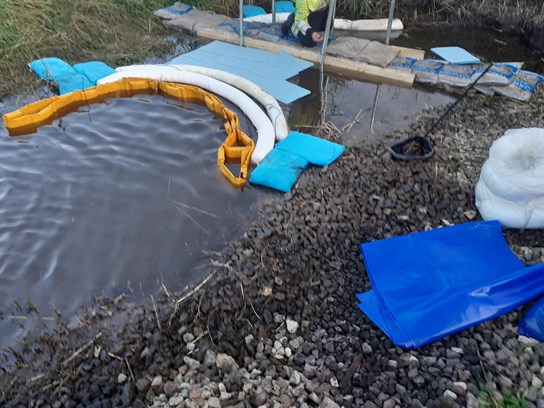
The bubble barrier installed to improve containment of the diesel at the pipe dam adjacent to the wetland when the tidal influence is strong is working well and is being monitored around the clock.
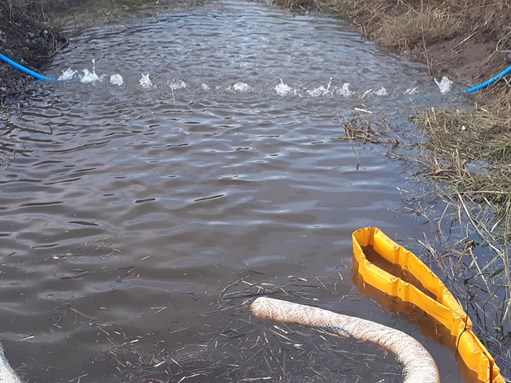
Boat surveys will be carried out tomorrow to assess the diesel impact within the estuary at hard to reach locations, as well as the continued monitoring and sampling on the ground.
1 September
The recovery of diesel from the derailed wagons has now been completed, with about 400,000 litres removed from the site and transported to Puma Energy.
Work to clear vegetation continues. This is to make space for the crane to move the wagons from 2 September, and to provide further safe access points to the site. The work is being overseen by an ecologist to minimise the impact on wildlife in the area.
Removal of diesel contained around the track within the ditches and by pipe dams across water courses continues with 21,600 litres of product recovered from these locations within the past 24 hours.
A temporary bubble barrier has been installed to hold back the product at the pipe dam adjacent to the wetlands due to the volume of product within this area. These areas are continuously monitored, with booms and absorbent mats replaced when required.
31 August
Over the weekend, the compound has been busy with machinery and vehicles, so local homes will have seen an increase in traffic around the area.
Work continues every day to drain the diesel from the wagons in preparation for their removal. Network Rail, Puma Energy, DB Cargo and their contractors have already successfully pumped thousands of litres from the tanks and the ditch in the surrounding area.
They will be carrying out vegetation removal to enable a safe place for a Kirow Crane to be placed, which will be used to move the freight wagons. This activity will start Monday evening and continue into Tuesday. It is estimated that two wagons per day will be able to be removed.
Check Network Rail’s website for the latest updates.
30 August
Work is continuing to recover the diesel from the derailed wagons and the spilled diesel. Trenches have been dug to intercept the diesel and vacuuming and skimming operations are taking place. Monitoring of local watercourses continues, with booms and absorbent pads being used and regularly replaced to contain as much of the diesel as possible. These techniques are proved to be working well and are removing a considerable quantity of diesel from the water courses.
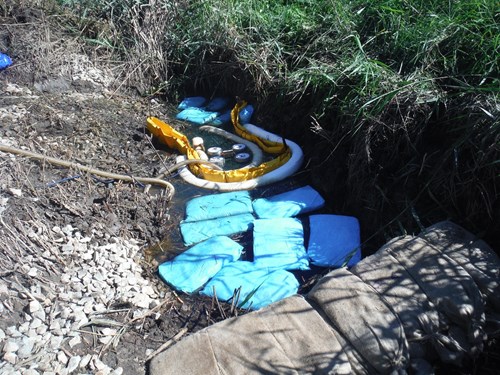

Network Rail is arranging for a crane to be delivered to the site on Monday evening (31 August) to start removing the wagons from Tuesday (1 September).
Liquid and solid waste is being collected and taken to appropriately permitted waste treatment sites.
How is the environmental impact on the wider area being assessed?
The Wales Environment Group has convened and is working to actively monitor and model the wider impact on the environment and public health. This information is used to guide the actions of organisations in minimising the off-site impacts on people and nature.
The group is chaired by NRW and includes representatives from Public Health Wales, Food Standards Agency, Carmarthenshire, Swansea and Pembrokeshire local authorities, Welsh Government Fisheries Department, Maritime and Coastguard Agency, Centre for Environment, Fisheries and Aquaculture Science (CEFAS), the RSPCA and Operators working at the site.
What is the extent of the oil pollution around the estuary?
8 September
We and our public protection partners are continuing to monitor shellfish. Samples are being sent to the Centre for Environment, Fisheries and Aquaculture Science (Cefas) laboratory in Lowestoft for analysis. Results are expected in two weeks, due to the complexity of the analysis being carried out.
Cefas is continuing with its daily modelling of the likely spread of diesel around the estuary using current data on wind, tide and river flow.
Most recent Cefas modelling estimates that over half of the diesel that escaped into the estuary has either evaporated or biodegraded.
4 September
Shoreline surveys along the Loughor Estuary were carried out yesterday and today, with samples taken of water, sediment, invertebrates and cockles to be taken away and tested for presence of diesel.
The analysis of the cockles is carried out by the Centre for Environment, Fisheries and Aquaculture Science (Cefas) and it will be a few days until results are available. These samples will inform the advice that the Food Standards Agency (FSA) will give in relation to the reopening of the cockle beds and shell fisheries in the area.
At the moment the FSA advises there is a small risk that fish and shellfish could have been exposed to diesel. Although the risk is thought to be low, the FSA advises as a precaution that anglers who continue to fish at the Loughor Estuary & Bury Inlet should avoid consuming any fish they have caught, and the cockle beds remain closed.
Cefas also carries out daily modelling of the likely spread of diesel around the estuary using current data on wind, tide and river flow. The recent model shows small concentrations of diesel now reaching the outer estuary, which is proved by some observations of oil sheen on the high tide on the south side of the outer estuary, west of Crofty.
Cefas also estimates that almost half of the diesel that escaped into the estuary has either evaporated or biodegraded.
31 August
Our marine monitoring team has been busy over the weekend in response to the diesel spill near Llangennech. They’ve been surveying to identify areas that have been oiled and taking samples of sediment to look at the impact on the wildlife of the Loughor Estuary. These photos were taken near the Loughor Bridge where the diesel has been found on the high tide mark and also within the surface sediments.
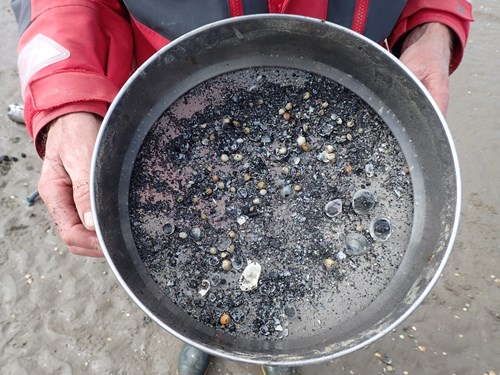
The Maritime and Coastguard Agency has also carried out an aerial survey to help monitor the movement of the diesel around the estuary. Survey work is likely to continue for the next few weeks and will help identify areas that need to be cleaned up.
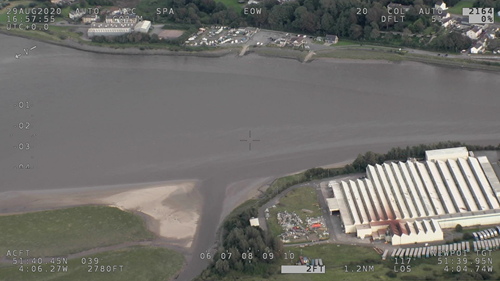
30 August
Monitoring teams continue to carry out daily surveys around the Loughor Estuary, including around the local fisheries and bathing water sites.
Diesel is no longer confined to the upper reaches of the estuary (around the Loughor Bridge and upstream) and has been observed at many locations as far as Crofty.
The Maritime and Coastguard Agency has undertaken aerial surveys to aid the monitoring of the pollution.
The map below shows the observed presence of diesel in the Loughor Estuary on 29 August 2020. The estuary is a very dynamic system influenced constantly by tide and wind, and will influence the movement of the diesel.
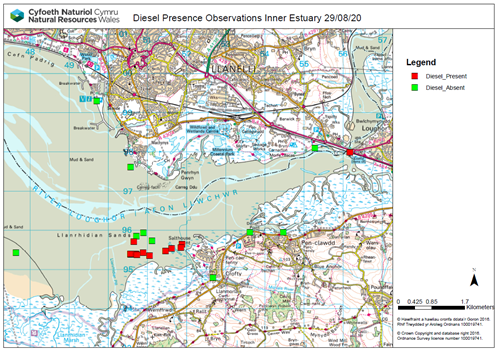
Operators at the site are currently working to contain and remove diesel from the vicinity of the derailment and are drawing up longer term remediation plans to clean up the site and impacts of diesel in the wider estuary. The Environment Group set up in response to the incident will support and advise the response units on the identification and priorities for clean-up.
What’s the impact on the shellfisheries in the area?
The Loughor Estuary is home to important shellfisheries and cockle beds. The area almost completely empties at low tide, exposing extensive sandy areas supporting a thriving cockle industry.
The cockle beds and shellfisheries have been closed as a precaution, following advice from the Food Standards Agency.
The Environment Group is coordinating regular sampling and testing of the sediment and cockles in these areas.
What's the advice to anglers?
Due to the spillage of diesel there is a small risk that fish and shellfish could have been exposed to contaminants from the diesel fuel. The risk of harmful contamination of fish is thought to be low. However, until this can be confirmed by environmental monitoring and the samples taken around the estuary are analysed, the Food Standards Agency advises, as a precaution, that anglers who continue to fish at the Loughor Estuary & Bury Inlet should avoid consuming any fish they have caught.
What should you do if you see oil around the estuary?
Please report sightings of oil pollution around the Loughor Estuary to us by calling 03000 65 3000. Make note of the exact location and take photos if you can to send to us.
What is the public health advice?
Public Health Wales states that it is unlikely that anyone exposed to the diesel for a short period of time will have any adverse health effects, but it is still sensible to avoid contact with diesel or the water in contaminated areas.
Diesel can produce vapours which are odorous. Odours are generally noticeable at concentrations well below those that cause harm, but high concentrations can cause dizziness, drowsiness and headaches. If you encounter odours move away from the area and into fresh air.
If anyone gets diesel on their skin, they should remove any affected clothing and wash themselves using soap and water and if they feel unwell seek medical attention.
It is also advised that all pets are kept out of contact with the diesel and that members of the public do not pick up any birds or other animals affected by diesel from the shoreline.
Read Public Health Wales’ statement in English
Read Public Health Wales’ statement in Welsh
31 August
Based upon the advice provided by Public Health Wales, Swansea and Carmarthenshire councils advise beach goers that while it is unlikely that anyone exposed to the diesel for a short period of time will have any adverse health effects, it is still sensible to avoid contact with diesel or coastal and estuarine water where diesel is visible or odours are noticeable.
What should you do if you see wildlife contaminated with oil?
If you come across any contaminated birds or animals, call the RSPCA on 0300 1234 999.
Contaminated wildlife need specialist washing facilities. Please do not wash birds or animals yourselves.
Statements
18 September 2020
Three weeks have passed since the freight train derailment and diesel spill incident in Llangennech, Carmarthenshire (26 August).
The site of the incident has changed dramatically. A team of experts from Natural Resources Wales (NRW), Network Rail, specialist contractors Adler and Allan, and Jacobs, has been working hard to remove the damaged vehicles and track, and contain and remove the diesel and contaminated land from site.
With advice and support from the Wales Environment Group, they are continuing with monitoring of the area and mitigating the risk of further spread of the diesel contamination by building temporary dams, using booms and bubble bars and monitoring any movement of the diesel in the land through boar holes.
Stuart Thomas, NRW’s incident recovery manager, said:
“Contractors Adler & Allan and Jacobs are continuing their work to contain and remove the diesel from the incident site and their efforts appear to be working well.
“Monitoring, modelling and assessment work is continuing and as we move into the recovery phase of the incident we will be able to learn more about the possible long-term effects of the diesel spill on the environment and local economy and the next steps we can take to minimise its impact in the coming months.”
The Loughor Estuary cockle beds remain closed as a safety precaution. Cockle gatherers are being regularly updated of the current situation.
An FSA spokesperson said:
“Our priority is to ensure that shellfish from the beds in the Loughor Estuary do not pose a risk to public health. Therefore, we continue to work with partner organisations to determine if there are any food safety implications for shellfish and cockles harvested in this location as a result of this incident.
“All shellfish beds remain closed on a precautionary basis to allow for initial sampling and testing of sediment, water and shellfish flesh. It is anticipated that results from this sampling will give a clearer indication as to the effects of the incident on the beds, and this will influence future decisions on reopening.”
28 August 2020
Natural Resources Wales (NRW) is working closely with partners to assess and advise on the environmental impact of the freight train fire and diesel spill near Llangennech.
Officers from NRW are on site to advise the containment and recovery of the diesel to prevent any further pollution of the Loughor Estuary.
The Wales Environment Group has convened and is working to actively monitor and model the impacts on the environment and public health.
This information is used to guide the actions of organisations in minimising the impacts on people and nature.
The group is chaired by NRW and includes representatives from Public Health Wales, Food Standards Agency, Carmarthenshire, Swansea and Pembrokeshire county councils, Welsh Government Fisheries Department, Maritime Coastguard Agency and Centre for Environment, Fisheries and Aquaculture Science (CEFAS).
Cockle beds and shell fisheries have been closed as a precaution, following advice from the Food Standards Agency.
Ben Wilson, duty incident manager for NRW, said:
“We’re doing everything in our power to mitigate the impacts of this incident. Our priority at this time is to work with our partners at the incident scene to contain the diesel spill and prevent it from polluting the Loughor Estuary any further.
“We also have monitoring teams out assessing the extent of the pollution. Their work will help the multi-agency Wales Environment Group to assess the wider environmental impact at sites such as the local fisheries and bathing water sites, and any effect on wildlife in the area.
“Initial modelling suggests that oil pollution is currently restricted to the upper reaches of the estuary around Loughor Bridge. This is supported by observations on site.
“We’re also keeping partner organisations and people who have interests within the area, such as farmers and cockle licence holders, informed of the situation.”
